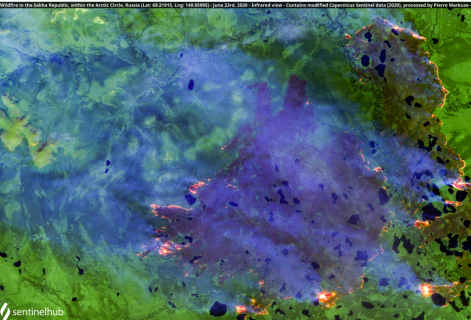Krasnoyarsk scientists: not only climate change is to blame for the Siberian fires of 2020
20 November 2020 г.

The area of Siberia exceeds 10 million square kilometers, most of this area is occupied by forests. Typically, the fire season in Russia begins in March in southern Siberia and gradually moves northward following warming weather and melting snow. Fires in the Far North burn thousands of kilometers of forest every year. Scientists carefully monitor fires occurring in such areas, analyze their course and anomalies.
Researchers from the Federal Research Center "Krasnoyarsk Science Center of SB RAS", together with colleagues from the United States, analyzed the frequency and area of fires in Siberia from March to September 2020. They found that this year's fire season is not unique, neither is it an abnormal response to climate change.
It is possible to track fires using satellite monitoring data. Fires change the surface reflectivity and temperature, making them rather easy to detect. Scientists found out that in 2020, almost 15 thousand fires were registered in Siberia. The total area of fires was 25.5 million hectares, with 8.4 million hectares affected by the natural disaster in the steppe areas of southern Siberia, about 3.5 million in the tundra, and 14.3 million in forests.
The number and size of fires significantly varied in different zones. In the south, there were a lot of small fires, while in the north, fires were rare but large-scale. These differences are associated with the types of vegetation in the regions, types of fire and rate of its natural extinction. Despite such large coverage, scientists do not consider the 2020 fire season to be unique.
“This year is unusual in terms of the duration of the anticyclone over Siberia, which was about 40 days. The data obtained from the areas covered by fire show that this year severe fires are associated with a summer drought in northern regions, especially in northeastern Siberia. In March, fires began at low latitudes, and in April spread to mid-latitudes. After the calm May, in June and July, fires began with renewed vigor, and active burning continued in the boreal forest zone and tundra until September. The fires finally ended only in October, due to natural changes in the meteorological situation, ” explains Yevgeny Ponomarev, Candidate of Technical Sciences, senior researcher at the V.N. Sukachev Institute of Forest SB RAS.
The relationship between the frequency or severity of fires and climate change cannot be estimated over a single season. Fires occur every year. Many factors influence the intensity of fires. Strong fires in Siberia are associated with stable anticyclones, during which high pressure, transparent atmosphere and active insolation are observed; at this time there are no clouds, it is clear and sunny. In such a situation combustible materials dry out, thus, creating conditions (better to say ‘prerequisites’) for fires. As a rule, there are a lot of them at once, and thus, large areas burn out. The fire spreads larger in the areas where high temperatures and drought persist for a long time. At the same time, stable summer anticyclones in Siberia are a common and annual process. Earlier, in 2001, 2005, 2013 and the sensational 2019, there were also many fires in Siberia. This natural phenomenon has its own periodicity.
Scientists note that even if we exclude anomalous years from the statistics, the portion of fire areas in high latitudes has increased by more than one percent over ten years. Researchers believe that this can prove the influence of climate warming on the spread of fires. But to confirm this, longer observations are required.
“We cannot say that this year is unique because the climate has changed. But not only the number of fires is growing, there is a general tendency for the areas disturbed by fire to increase. One cannot deny that the climate affects fires; even cursory calculations show a change in temperature and the redistribution of precipitation. But this influence is not as fatal as the media say. It takes years to adequately assess what is happening, ” says the author of the study, Yevgeny Ponomarev.
Share:
